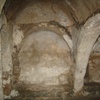Disclaimer
This entry contains information known to us from a variety of sources but may not include all the information currently available. Please be in touch if you notice any inadvertent mistakes in our presentation or have additional knowledge or sources to share. Thank you.
Archive
Qabliya (Kabliya) Synagogue, Yefren (Yefran, Yifrin, יפרן, يفرن), Libya
The ancient Qabliya (Kabliya, קאבלייה) synagogue is located in Yefren (יפרן, يفرن), Libya. It is also called the Ghariba (גריבה / מופלאה) or Nataliah (נטליה) synagogue according to some. Tradition says the Qabliya contains a stone that was carried by exiles all the way from the Second Temple.
Description
Nestled in the Nafusa mountains is the Qabliya (Kabliya) Synagogue, a two-thousand-year-old synagogue guarded by Muslims in the small ancient city of Yefren. Yefren's name is representative of both the geographic location and physical aesthetic of its synagogues, schools, and homes. The name Yefren comes from the Berber root Afri, also the source of the name Africa and the name of the Berber Goddess Afri. One of the meanings associated with this root is "cave" or "hole ", and hence the troglodyte caves associated with the history of the area, which is also common to the neighboring Tunisian region.1 The name Qabliya, meaning “before” in Arabic, may reflect the synagogue’s resemblance to an ancient cave.2 Another theory relates the name Qabliya to its location as the inland synagogue that is encountered “before” the sea. The other synagogue in the village is located closer to the coast and is known as the Bahri (בחרי, بحري) synagogue.
There is a struggle to protect this significant synagogue from deterioration. With six arches and six windows, echoing the Star of David, stones carried from the Second Temple by exiles in Jerusalem, and imprinted hands along the roof, the evidence of this synagogue is significant in understanding the history of Jewish diaspora.3 Yefren was once the epicenter of a two-millennia-old Jewish community in Libya with a dozen synagogues and nearly forty thousand residents.4
Jewish Community in Yefren:
Yefren is a mountain city, located in the western region of Libya some 132 km to the southwest of Tripoli.5 The Jewish community in Libya itself dates back to the third century BCE and at its peak numbered around thirty-eight thousand people, although it was always the smallest of the Jewish populations in Northern Africa.6 Jews and Berbers have attempted to coexist in Yefren with some periods of success and other instances of seizes and displacement.7 Cultural tensions between these two groups are recorded through Yefren and much of Libya in many of their buildings, as many villages around Yefren bear the mark of the Libyan Jews, who until their departure to the newly-created nation of Israel in 1948, constituted half the city’s population.8 Although many sites remain undestroyed, the Ghriba synagogue, for example, displays tension through a pattern of overlapping inscriptions in Hebrew aiming to replace those inscriptions in Amazigh, the language of the Berbers.9
Sources
Photos:
http://www.gettyimages.com/detail/news-photo/libyan-omar-aboud-from-the-ancient-amazigh-tribe-stands-news-photo/119881878#libyan-omar-aboud-from-the-ancient-amazigh-tribe-stands-inside-one-of-picture-id119881878
http://www.gettyimages.com/detail/news-photo/libyan-omar-aboud-from-the-ancient-amazigh-tribe-opens-the-news-photo/119881874#libyan-omar-aboud-from-the-ancient-amazigh-tribe-opens-the-door-of-picture-id119881874
Endnotes
[1] Temehu.com. "Yefren." Yefren (Ifren). Accessed June 28, 2017. https://www.temehu.com/Cities_sites/Yefren.htm.
[2] Syafiuddin, Akhmad. “The Meaning of Qabliyah and Ba’diyah in Prayer - Page 2 of 2.” Guidelines Islamic Law, March 27, 2021. https://guidelinesislamiclaw.com/meaning-of-qabliyah-and-badiyah-in-prayer/.
[3] Bataween. "Point of No Return: Jewish Refugees from Arab Countries." Berber Muslim looks after Libyan synagogue. April 11, 2012. http://jewishrefugees.blogspot.com/2012/04/berber-muslim-looks-after-libyan.html.
[4] Temehu.com. "Yefren." Yefren (Ifren).
[5] The Libya Observer."Discover Libya - Yefren". Filmed [February 2017]. YouTube video 22:35. Posted [Febraury 2017]. https://www.youtube.com/watch?v=nYj7zUCh3fw.
[6] "Libyan Jews shed no tears for Gaddafi." Ynetnews. Accessed July 03, 2017. http://www.ynetnews.com/articles/0,7340,L-4123869,00.html.
[7] Reuters. "Libyan rebels seize mountain town of Yafran." The Jerusalem Post | JPost.com. June 06, 2011. Accessed July 05, 2017. http://www.jpost.com/Breaking-News/Libyan-rebels-seize-mountain-town-of-Yafran.
[8] Ibid.
[9] "Libyan Berbers cherish shared history with their country’s Jews." Alarabiya.net. Accessed July 05, 2017. https://www.alarabiya.net/articles/2011/07/22/158842.html.
Works Cited
Temehu.com. "Yefren." Yefren (Ifren). Accessed June 28, 2017. https://www.temehu.com/Cities_sites/Yefren.htm.
The Libya Observer."Discover Libya - Yefren." Filmed [February 2017]. YouTube video 22:35. Posted [Febraury 2017]. https://www.youtube.com/watch?v=nYj7zUCh3fw.
Lipman, Steve, Joshua Mitnick, Amy Sara Clark, Gary Rosenblatt, Curt Schleier, Jta, Elisha Wiesel, Rabbi Abigail Treu, Jewish Week Editors, and Rabbi Marci N. Bellows. "A Remnant Of Libya's Jewish Past." Jewish Week. July 19, 2011. http://jewishweek.timesofisrael.com/a-remnant-of-libyas-jewish-past/.
Bataween. "Point of No Return: Jewish Refugees from Arab Countries." Berber Muslim looks after Libyan synagogue. April 11, 2012. http://jewishrefugees.blogspot.com/2012/04/berber-muslim-looks-after-libyan.html.
Jaide, Don. "Rasta Livewire." The Place for Africa on the Net. Accessed July 04, 2017. http://www.africaresource.com/rasta/sesostris-the-great-the-egyptian-hercules/ephraimite-moors-by-amir-ishaq-d-al-sulaimani/.
"Libyan Jews shed no tears for Gaddafi." Ynetnews. Accessed July 03, 2017. http://www.ynetnews.com/articles/0,7340,L-4123869,00.html.
Reuters. "Libyan rebels seize mountain town of Yafran." The Jerusalem Post | JPost.com. June 06, 2011. http://www.jpost.com/Breaking-News/Libyan-rebels-seize-mountain-town-of-Yafran.
"Libyan Berbers cherish shared history with their country’s Jews." Alarabiya.net. Accessed July 05, 2017. https://www.alarabiya.net/articles/2011/07/22/158842.html.
Coordinates courtesy Mr. M. Longari







